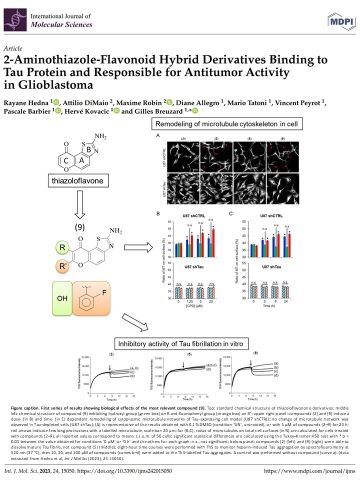BREUZARD Gilles
Onglets principaux

Team
Platform
Localisation
Domaines de recherche
Resarch project #1
As life expectancy continues to rise in industrialized countries, neurodegenerative pathologies such as Alzheimer’s disease (AD) will have increasingly damaging effects on public health. In addition to deposits of β-amyloid protein, AD is also characterized by the formation of toxic neurofibrillary tangles constituted of hyperphosphorylated Tau in neurons. Hence, it appears crucial to find druggable AD-associated Tau protein. In collaboration with Dr Maxime Robin (IMBE CNRS UMR7263, AMU, Marseille), we are currently working on several flavonoid derivatives grafted with a 2-amino-thiazole chemical group, thiazoloflavonoid (TZF), these compounds having been developed for inhibitory activity on Tau fibrillation (patent no. WO2016083490A1). Recently, a first series of derivatives has been tested to demonstrate the efficacy of TZFs specifically targeting Tau as anti-tumor agents (laureate project of Cancéropôle PACA's AAP Emergence 2021; thesis work by Miss Hedna; Hedna et al, 2023). These initial encouraging data suggest strongly that molecules exhibit dual therapeutic properties, both with anticancer and anti-neurodegenerative properties in a tauopathy context, and it requires to further develop the project. The primary objective of the scientific program is to evaluate the therapeutic contribution of new series of TZFs in tauopathology models (molecular, cellular, animal models). The secondary objective is to understand the mechanism of action of Tau-targeting TZF in order to revisit their formulation. The methodologies of this topic involve biophysics methods applied 1/ in solute such as turbidimetry and spectrofluorometry approaches to characterize modalities of the binding of new TZFs to the Tau protein; 2/ in AD cell model such as a BiFC approach coupled to FRET method (Förster Resonance Energy Transfer) as a fluorescent conformational-sensitive Tau sensor; and 3/ in AD mouse model to determine the biological effects of new TZFs on the state of hyperphosphorylated and/or aggregated Tau. Finally, the approaches developed for this program is decisive for the design of drugs targeting more efficiently the Tau protein in AD development.
Research project #2 Biophysical approach of the interaction between tau, microtubule and actin in cancer cell – an issue in the fight against the progression of glioblastoma
Despite recent advances, the number of patients with glioblastoma (GBM) is increasing and the main reason for treatment failures remains the ineffectiveness of conventional treatments for other cancers. Moreover, the dysfunction of cell migration in GBM is a proven factor of the disease. This process involves strong cell shape modifications and thus heavily relies on the redistribution and cooperation of cytoskeletal filamentous proteins, notably actin filaments and microtubules (MT). While the requirement of a crosstalk between MTs and actin is not questioned, mechanisms underlying the MT-actin organization by cross-linkers remain largely unexplored. In particular, little is known about the functional contribution of microtubule-associated proteins (MAPs) such as Tau known as a prominent stabilizer of MTs and promoting in vitro co-organization of MT and actin networks. Thus, a complete understanding of how cytoskeletal filaments contribute to biological functions in cell migration and more generally cell shape changes requires a deeper knowledge of how Tau governs cross-talk of MT and actin cytoskeletons. This scientific program aims at deciphering the role of Tau in cell migration and the progression of GBM. Our hypothesis of work is that by interacting with both MTs and actin cytoskeletons, Tau could assist in addressing the (+) end of MTs to focal contacts (a phenomenon called ‘targeting’) necessary to cell adhesion to extracellular matrix. We propose (1) to characterize the interaction of Tau with both MTs and actin filaments directly in the cell; (2) to explore the interaction-activity relationship of Tau on major signaling pathways involved in cell migration, such as the Rho GTP-ase proteins (Rho, Rac, Cdc42); (3) to determine the impact of phosphorylation of Tau on three residues candidate as prognostic markers of GBM; and (4) to determine the impact of new thiazole-fused flavonoid derivatives (TZF) on the co-interactions of Tau with MT and actin cytoskeletons. The methodologies of this topic involve a combination of optical instrumentation (FRET and FRAP imaging) and biological studies. Understanding the molecular mechanisms that regulate the activity of MAPs, and in particular the tau protein, in the context of tumor progression will improve fundamental knowledge about these MT regulatory proteins. From a pharmacotherapeutic point of view, the study of their role in modulating the efficacy of new drugs can better predict the response to chemotherapy and possibly consider these MAPs as new targets in tumor cells. Finally, the approaches developed for this project is decisive for the design of drugs targeting more efficiently tau and microtubules.
Visuels
Publications
-
Therapeutic Contribution of Tau-Binding Thiazoloflavonoid Hybrid Derivatives Against Glioblastoma Using Pharmacological Approach in 3D SpheroidsInternational Journal of Molecular Sciences2024
-
2-Aminothiazole-Flavonoid Hybrid Derivatives Binding to Tau Protein and Responsible for Antitumor Activity in GlioblastomaInternational Journal of Molecular Sciences2023
-
Binding of two zinc ions promotes liquid-liquid phase separation of TauInternational Journal of Biological Macromolecules2022
-
Tau Protein as Therapeutic Target for Cancer? Focus on GlioblastomaCancers2022
-
Myotoxin-3 from the Pacific Rattlesnake Crotalus oreganus oreganus Venom Is a New Microtubule-Targeting AgentMolecules2022
-
Tau Regulates Glioblastoma Progression, 3D Cell Organization, Growth and Migration via the PI3K-AKT AxisCancers2021
-
Tau regulates the microtubule-dependent migration of glioblastoma cells via the Rho-ROCK signaling pathwayJournal of Cell Science2019
-
Saccharomyces boulardii CNCM I-745 Restores intestinal Barrier Integrity by Regulation of E-cadherin RecyclingJournal of Crohn's and Colitis2017
-
Synthesis and biological evaluation of 4 arylcoumarin analogues as tubulin-targeting antitumor agentsBioorganic and Medicinal Chemistry2017
-
Interactions of long-chain homologues of colchicine with tubulinEuropean Journal of Medicinal Chemistry2017
-
Tau Interaction with Tubulin and Microtubules: From Purified Proteins to Cells2017
-
Direct evidence for the interaction of stathmin along the length and the plus end of microtubules in cellsFASEB Journal2016
-
Deciphering the molecular mechanisms of anti-tubulin plant derived drugsPhytochemistry Reviews2014
-
Molecular mechanisms of Tau binding to microtubules and its role in microtubule dynamics in live cells.Journal of Cell Science2013
-
FRET and FRAP imaging: Approaches to characterise tau and stathmin interactions with microtubules in cellsBiology of the Cell2013
-
Microtubule-Associated Proteins and Tubulin Interaction by Isothermal Titration Calorimetry2013
-
Exosomal Lipids Impact Notch Signaling and Induce Death of Human Pancreatic Tumoral SOJ-6 CellsPLoS ONE2012
-
An optimized extended DNA kappa B site that enhances plasmid DNA nuclear import and gene expressionThe Journal of Gene Medicine2009
-
Nuclear delivery of NFkappaB-assisted DNA/polymer complexes: plasmid DNA quantitation by confocal laser scanning microscopy and evidence of nuclear polyplexes by FRET imaging.Nucleic Acids Research2008
-
Synthesis and transfection activity of new cationic phosphoramidate lipids: High efficiency of an imidazolium derivativeChemBioChem2008
-
Polymer-Based Gene Delivery: A Current Review on the Uptake and Intracellular Trafficking of PolyplexesCurrent Gene Therapy2008
-
Intracellular trafficking and nuclear import of polyplexes by FRET coupled with cellular imagingHuman Gene Therapy2007





